sensor Lancia Musa 2010 Owner handbook (in English)
[x] Cancel search | Manufacturer: LANCIA, Model Year: 2010, Model line: Musa, Model: Lancia Musa 2010Pages: 218, PDF Size: 3.71 MB
Page 91 of 218
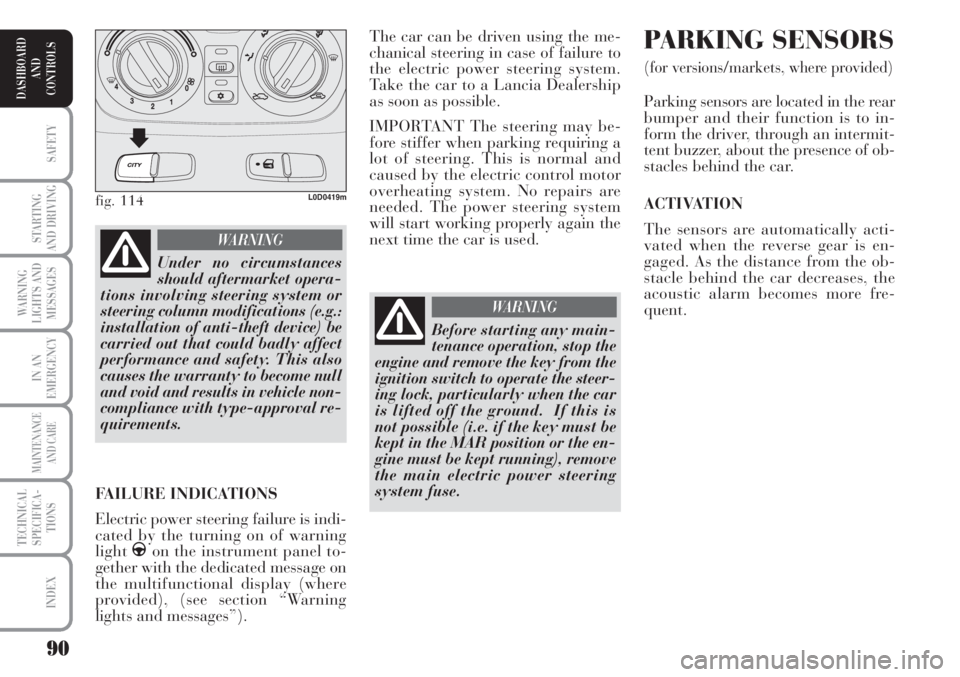
90
SAFETY
STARTING
AND DRIVING
WARNING
LIGHTS AND
MESSAGES
IN AN
EMERGENCY
MAINTENANCE
AND CARE
TECHNICAL
SPECIFICA-
TIONS
INDEX
DASHBOARD
AND
CONTROLS
The car can be driven using the me-
chanical steering in case of failure to
the electric power steering system.
Take the car to a Lancia Dealership
as soon as possible.
IMPORTANT The steering may be-
fore stiffer when parking requiring a
lot of steering. This is normal and
caused by the electric control motor
overheating system. No repairs are
needed. The power steering system
will start working properly again the
next time the car is used. PARKING SENSORS
(for versions/markets, where provided)
Parking sensors are located in the rear
bumper and their function is to in-
form the driver, through an intermit-
tent buzzer, about the presence of ob-
stacles behind the car.
ACTIVATION
The sensors are automatically acti-
vated when the reverse gear is en-
gaged. As the distance from the ob-
stacle behind the car decreases, the
acoustic alarm becomes more fre-
quent.
fig. 114L0D0419m
Under no circumstances
should aftermarket opera-
tions involving steering system or
steering column modifications (e.g.:
installation of anti-theft device) be
carried out that could badly affect
performance and safety. This also
causes the warranty to become null
and void and results in vehicle non-
compliance with type-approval re-
quirements.
WARNING
FAILURE INDICATIONS
Electric power steering failure is indi-
cated by the turning on of warning
light
gon the instrument panel to-
gether with the dedicated message on
the multifunctional display (where
provided), (see section “Warning
lights and messages”).
Before starting any main-
tenance operation, stop the
engine and remove the key from the
ignition switch to operate the steer-
ing lock, particularly when the car
is lifted off the ground. If this is
not possible (i.e. if the key must be
kept in the MAR position or the en-
gine must be kept running), remove
the main electric power steering
system fuse.
WARNING
Page 92 of 218
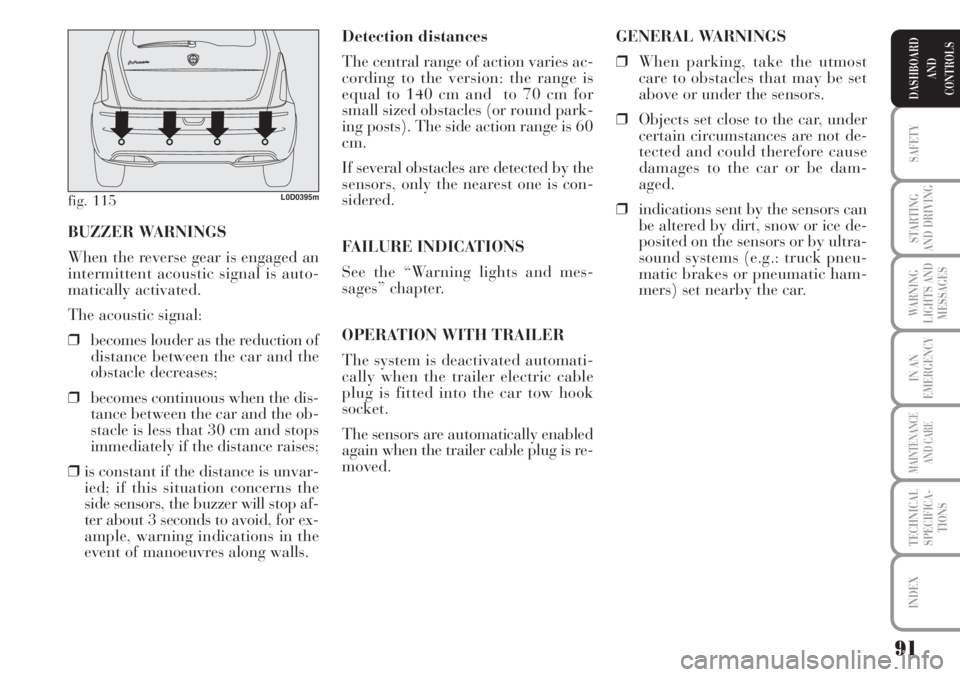
91
SAFETY
STARTING
AND DRIVING
WARNING
LIGHTS AND
MESSAGES
IN AN
EMERGENCY
MAINTENANCE
AND CARE
TECHNICAL
SPECIFICA-
TIONS
INDEX
DASHBOARD
AND
CONTROLS
Detection distances
The central range of action varies ac-
cording to the version: the range is
equal to 140 cm and to 70 cm for
small sized obstacles (or round park-
ing posts). The side action range is 60
cm.
If several obstacles are detected by the
sensors, only the nearest one is con-
sidered.
FAILURE INDICATIONS
See the “Warning lights and mes-
sages” chapter.
OPERATION WITH TRAILER
The system is deactivated automati-
cally when the trailer electric cable
plug is fitted into the car tow hook
socket.
The sensors are automatically enabled
again when the trailer cable plug is re-
moved. BUZZER WARNINGS
When the reverse gear is engaged an
intermittent acoustic signal is auto-
matically activated.
The acoustic signal:
❒becomes louder as the reduction of
distance between the car and the
obstacle decreases;
❒becomes continuous when the dis-
tance between the car and the ob-
stacle is less that 30 cm and stops
immediately if the distance raises;
❒is constant if the distance is unvar-
ied; if this situation concerns the
side sensors, the buzzer will stop af-
ter about 3 seconds to avoid, for ex-
ample, warning indications in the
event of manoeuvres along walls.
fig. 115L0D0395m
GENERAL WARNINGS
❒When parking, take the utmost
care to obstacles that may be set
above or under the sensors.
❒Objects set close to the car, under
certain circumstances are not de-
tected and could therefore cause
damages to the car or be dam-
aged.
❒indications sent by the sensors can
be altered by dirt, snow or ice de-
posited on the sensors or by ultra-
sound systems (e.g.: truck pneu-
matic brakes or pneumatic ham-
mers) set nearby the car.
Page 93 of 218
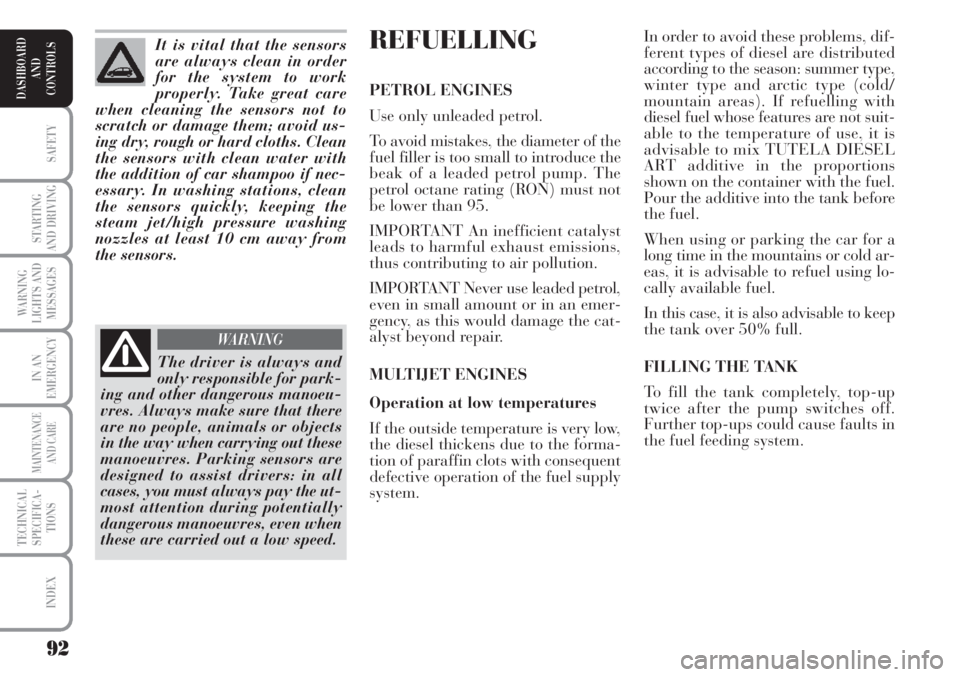
92
SAFETY
STARTING
AND DRIVING
WARNING
LIGHTS AND
MESSAGES
IN AN
EMERGENCY
MAINTENANCE
AND CARE
TECHNICAL
SPECIFICA-
TIONS
INDEX
DASHBOARD
AND
CONTROLS
REFUELLING
PETROL ENGINES
Use only unleaded petrol.
To avoid mistakes, the diameter of the
fuel filler is too small to introduce the
beak of a leaded petrol pump. The
petrol octane rating (RON) must not
be lower than 95.
IMPORTANT An inefficient catalyst
leads to harmful exhaust emissions,
thus contributing to air pollution.
IMPORTANT Never use leaded petrol,
even in small amount or in an emer-
gency, as this would damage the cat-
alyst beyond repair.
MULTIJET ENGINES
Operation at low temperatures
If the outside temperature is very low,
the diesel thickens due to the forma-
tion of paraffin clots with consequent
defective operation of the fuel supply
system.In order to avoid these problems, dif-
ferent types of diesel are distributed
according to the season: summer type,
winter type and arctic type (cold/
mountain areas). If refuelling with
diesel fuel whose features are not suit-
able to the temperature of use, it is
advisable to mix TUTELA DIESEL
ART additive in the proportions
shown on the container with the fuel.
Pour the additive into the tank before
the fuel.
When using or parking the car for a
long time in the mountains or cold ar-
eas, it is advisable to refuel using lo-
cally available fuel.
In this case, it is also advisable to keep
the tank over 50% full.
FILLING THE TANK
To fill the tank completely, top-up
twice after the pump switches off.
Further top-ups could cause faults in
the fuel feeding system. It is vital that the sensors
are always clean in order
for the system to work
properly. Take great care
when cleaning the sensors not to
scratch or damage them; avoid us-
ing dry, rough or hard cloths. Clean
the sensors with clean water with
the addition of car shampoo if nec-
essary. In washing stations, clean
the sensors quickly, keeping the
steam jet/high pressure washing
nozzles at least 10 cm away from
the sensors.
The driver is always and
only responsible for park-
ing and other dangerous manoeu-
vres. Always make sure that there
are no people, animals or objects
in the way when carrying out these
manoeuvres. Parking sensors are
designed to assist drivers: in all
cases, you must always pay the ut-
most attention during potentially
dangerous manoeuvres, even when
these are carried out a low speed.
WARNING
Page 95 of 218
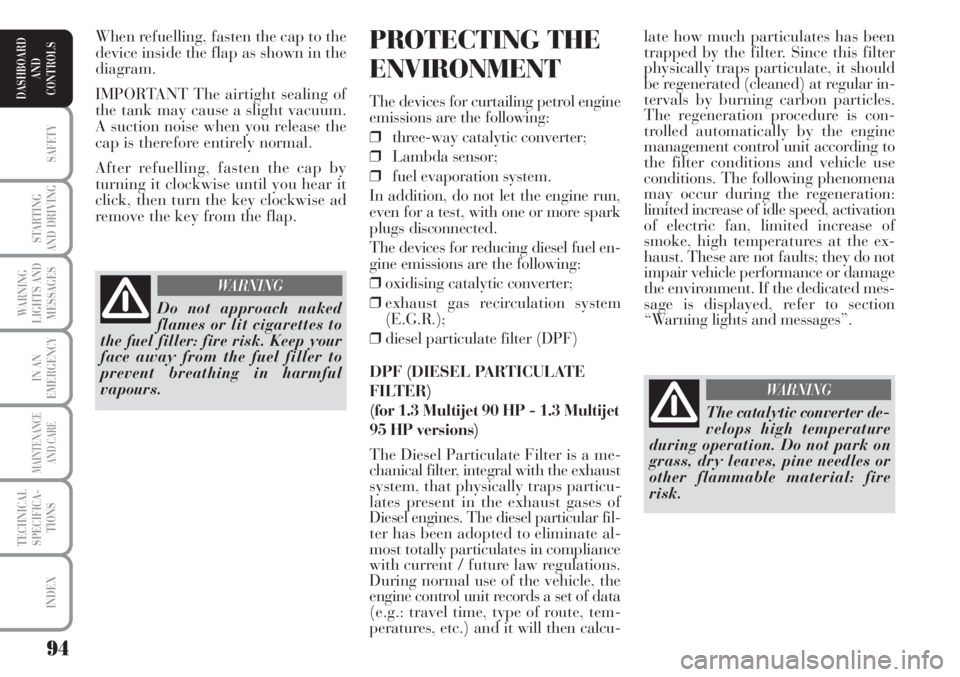
94
SAFETY
STARTING
AND DRIVING
WARNING
LIGHTS AND
MESSAGES
IN AN
EMERGENCY
MAINTENANCE
AND CARE
TECHNICAL
SPECIFICA-
TIONS
INDEX
DASHBOARD
AND
CONTROLS
late how much particulates has been
trapped by the filter. Since this filter
physically traps particulate, it should
be regenerated (cleaned) at regular in-
tervals by burning carbon particles.
The regeneration procedure is con-
trolled automatically by the engine
management control unit according to
the filter conditions and vehicle use
conditions. The following phenomena
may occur during the regeneration:
limited increase of idle speed, activation
of electric fan, limited increase of
smoke, high temperatures at the ex-
haust. These are not faults; they do not
impair vehicle performance or damage
the environment. If the dedicated mes-
sage is displayed, refer to section
“Warning lights and messages”.PROTECTING THE
ENVIRONMENT
The devices for curtailing petrol engine
emissions are the following:
❒three-way catalytic converter;
❒Lambda sensor;
❒fuel evaporation system.
In addition, do not let the engine run,
even for a test, with one or more spark
plugs disconnected.
The devices for reducing diesel fuel en-
gine emissions are the following:
❒oxidising catalytic converter;
❒exhaust gas recirculation system
(E.G.R.);
❒diesel particulate filter (DPF)
DPF (DIESEL PARTICULATE
FILTER)
(for 1.3 Multijet 90 HP - 1.3 Multijet
95 HP versions)
The Diesel Particulate Filter is a me-
chanical filter, integral with the exhaust
system, that physically traps particu-
lates present in the exhaust gases of
Diesel engines. The diesel particular fil-
ter has been adopted to eliminate al-
most totally particulates in compliance
with current / future law regulations.
During normal use of the vehicle, the
engine control unit records a set of data
(e.g.: travel time, type of route, tem-
peratures, etc.) and it will then calcu- When refuelling, fasten the cap to the
device inside the flap as shown in the
diagram.
IMPORTANT The airtight sealing of
the tank may cause a slight vacuum.
A suction noise when you release the
cap is therefore entirely normal.
After refuelling, fasten the cap by
turning it clockwise until you hear it
click, then turn the key clockwise ad
remove the key from the flap.
Do not approach naked
flames or lit cigarettes to
the fuel filler: fire risk. Keep your
face away from the fuel filler to
prevent breathing in harmful
vapours.
WARNING
The catalytic converter de-
velops high temperature
during operation. Do not park on
grass, dry leaves, pine needles or
other flammable material: fire
risk.
WARNING
Page 133 of 218
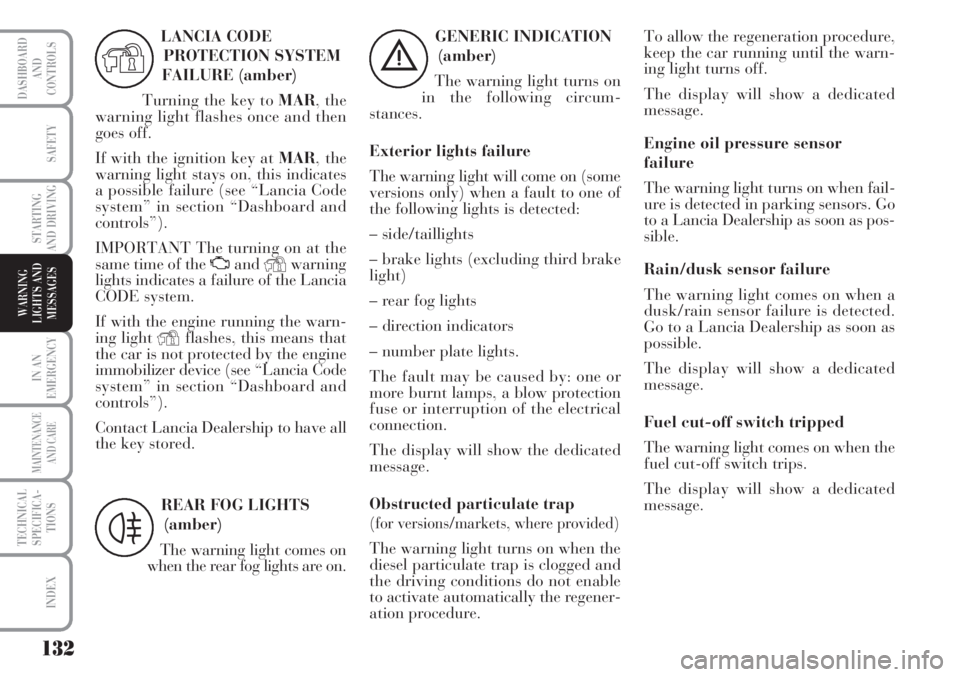
132
IN AN
EMERGENCY
MAINTENANCE
AND CARE
TECHNICAL
SPECIFICA-
TIONS
INDEX
DASHBOARD
AND
CONTROLS
SAFETY
STARTING
AND DRIVING
WARNING
LIGHTS AND
MESSAGES
GENERIC INDICATION
(amber)
The warning light turns on
in the following circum-
stances.
Exterior lights failure
The warning light will come on (some
versions only) when a fault to one of
the following lights is detected:
– side/taillights
– brake lights (excluding third brake
light)
– rear fog lights
– direction indicators
– number plate lights.
The fault may be caused by: one or
more burnt lamps, a blow protection
fuse or interruption of the electrical
connection.
The display will show the dedicated
message.
Obstructed particulate trap
(for versions/markets, where provided)
The warning light turns on when the
diesel particulate trap is clogged and
the driving conditions do not enable
to activate automatically the regener-
ation procedure.
è
To allow the regeneration procedure,
keep the car running until the warn-
ing light turns off.
The display will show a dedicated
message.
Engine oil pressure sensor
failure
The warning light turns on when fail-
ure is detected in parking sensors. Go
to a Lancia Dealership as soon as pos-
sible.
Rain/dusk sensor failure
The warning light comes on when a
dusk/rain sensor failure is detected.
Go to a Lancia Dealership as soon as
possible.
The display will show a dedicated
message.
Fuel cut-off switch tripped
The warning light comes on when the
fuel cut-off switch trips.
The display will show a dedicated
message. LANCIA CODE
PROTECTION SYSTEM
FAILURE (amber)
Turning the key to MAR, the
warning light flashes once and then
goes off.
If with the ignition key at MAR, the
warning light stays on, this indicates
a possible failure (see “Lancia Code
system” in section “Dashboard and
controls”).
IMPORTANT The turning on at the
same time of the Uand
Ywarning
lights indicates a failure of the Lancia
CODE system.
If with the engine running the warn-
ing light
Yflashes, this means that
the car is not protected by the engine
immobilizer device (see “Lancia Code
system” in section “Dashboard and
controls”).
Contact Lancia Dealership to have all
the key stored.
Y
REAR FOG LIGHTS
(amber)
The warning light comes on
when the rear fog lights are on.
4
Page 160 of 218
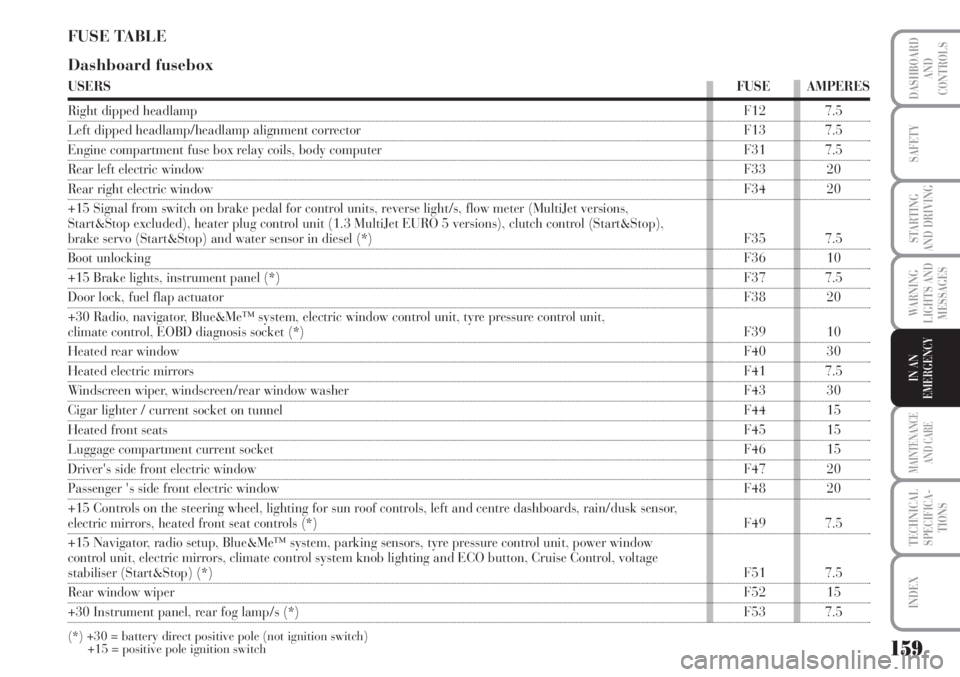
159
WARNING
LIGHTS AND
MESSAGES
MAINTENANCE
AND CARE
TECHNICAL
SPECIFICA-
TIONS
INDEX
DASHBOARD
AND
CONTROLS
SAFETY
STARTING
AND DRIVING
IN AN
EMERGENCY
FUSE TABLE
Dashboard fusebox
USERSFUSE AMPERES
Right dipped headlampF12 7.5
Left dipped headlamp/headlamp alignment corrector F13 7.5
Engine compartment fuse box relay coils, body computer F31 7.5
Rear left electric windowF33 20
Rear right electric windowF34 20
+15 Signal from switch on brake pedal for control units, reverse light/s, flow meter (MultiJet versions,
Start&Stop excluded), heater plug control unit (1.3 MultiJet EURO 5 versions), clutch control (Start&Stop),
brake servo (Start&Stop) and water sensor in diesel (*) F35 7.5
Boot unlocking F36 10
+15 Brake lights, instrument panel (*)F37 7.5
Door lock, fuel flap actuatorF38 20
+30 Radio, navigator, Blue&Me™ system, electric window control unit, tyre pressure control unit,
climate control, EOBD diagnosis socket (*)F39 10
Heated rear window F40 30
Heated electric mirrorsF41 7.5
Windscreen wiper, windscreen/rear window washer F43 30
Cigar lighter / current socket on tunnelF44 15
Heated front seatsF45 15
Luggage compartment current socketF46 15
Driver's side front electric windowF47 20
Passenger 's side front electric windowF48 20
+15 Controls on the steering wheel, lighting for sun roof controls, left and centre dashboards, rain/dusk sensor,
electric mirrors, heated front seat controls (*)F49 7.5
+15 Navigator, radio setup, Blue&Me™ system, parking sensors, tyre pressure control unit, power window
control unit, electric mirrors, climate control system knob lighting and ECO button, Cruise Control, voltage
stabiliser (Start&Stop) (*)F51 7.5
Rear window wiperF52 15
+30 Instrument panel, rear fog lamp/s (*)F53 7.5
(*) +30 = battery direct positive pole (not ignition switch)
+15 = positive pole ignition switch
Page 209 of 218
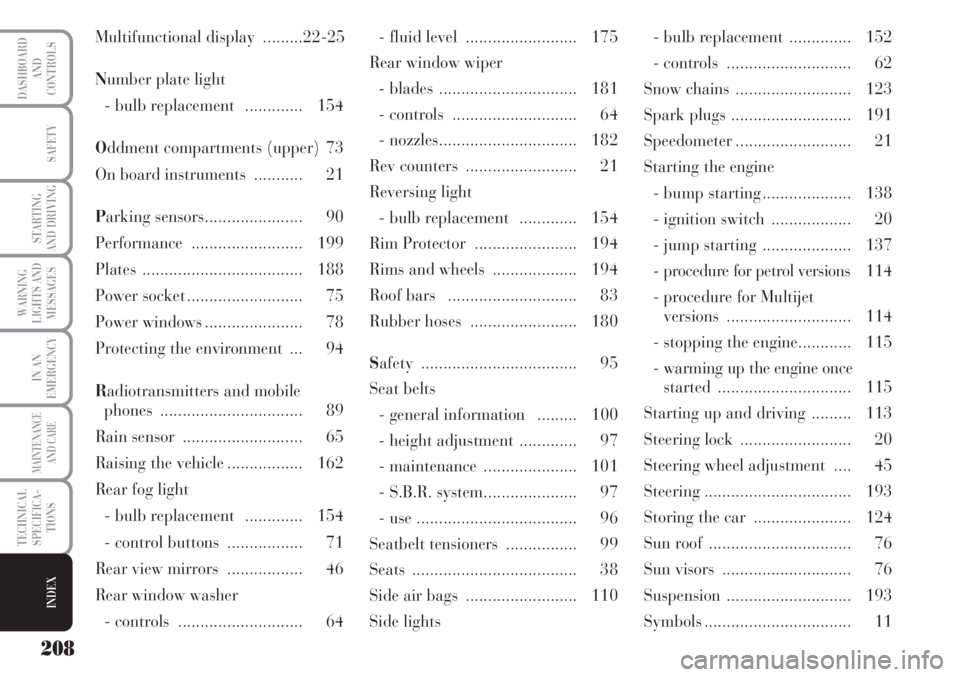
Multifunctional display .........22-25
Number plate light
- bulb replacement ............. 154
Oddment compartments (upper) 73
On board instruments ........... 21
Parking sensors...................... 90
Performance ......................... 199
Plates .................................... 188
Power socket .......................... 75
Power windows ...................... 78
Protecting the environment ... 94
Radiotransmitters and mobile
phones ................................ 89
Rain sensor ........................... 65
Raising the vehicle ................. 162
Rear fog light
- bulb replacement ............. 154
- control buttons ................. 71
Rear view mirrors ................. 46
Rear window washer
- controls ............................ 64- fluid level ......................... 175
Rear window wiper
- blades ............................... 181
- controls ............................ 64
- nozzles............................... 182
Rev counters ......................... 21
Reversing light
- bulb replacement ............. 154
Rim Protector ....................... 194
Rims and wheels ................... 194
Roof bars ............................. 83
Rubber hoses ........................ 180
Safety ................................... 95
Seat belts
- general information ......... 100
- height adjustment ............. 97
- maintenance ..................... 101
- S.B.R. system..................... 97
- use .................................... 96
Seatbelt tensioners ................ 99
Seats ..................................... 38
Side air bags ......................... 110
Side lights- bulb replacement .............. 152
- controls ............................ 62
Snow chains .......................... 123
Spark plugs ........................... 191
Speedometer .......................... 21
Starting the engine
- bump starting .................... 138
- ignition switch .................. 20
- jump starting .................... 137
- procedure for petrol versions 114
- procedure for Multijet
versions ............................ 114
- stopping the engine............ 115
- warming up the engine once
started .............................. 115
Starting up and driving ......... 113
Steering lock ......................... 20
Steering wheel adjustment .... 45
Steering ................................. 193
Storing the car ...................... 124
Sun roof ................................ 76
Sun visors ............................. 76
Suspension ............................ 193
Symbols ................................. 11
208
WARNING
LIGHTS AND
MESSAGES
DASHBOARD
AND
CONTROLS
SAFETY
STARTING
AND DRIVING
IN AN
EMERGENCY
MAINTENANCE
AND CARE
TECHNICAL
SPECIFICA-
TIONS
INDEX